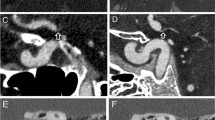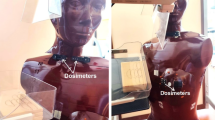Abstract
We examined the induction of dicentric chromosomes in human lymphocytes irradiated in vitro with nearly monoenergetic neutrons at energies in the range of 36 keV–15.0 MeV. For the assessment of the relative biological effectiveness (RBE) both 220 kV x-rays and 60Co γ-rays were used as reference radiations. To avoid potential confounding factors that would influence the outcome of the experiments, only blood from one individual was used. The neutron RBE culture conditions ensured that the chromosome analysis could be performed exclusively in metaphases of the first cell cycle in vitro. For the reference radiation of 220 kV x-rays, the values of RBEM were found to increase from 16.6 (En=36 keV) to the maximum value of 23.4 (En=385 keV). For 60Co γ-rays utilized as the reference radiation, the corresponding RBEM values were found to be higher by a factor of 4. These results agree well with the previously published large data sets of three laboratories on dose-response relationships for dicentrics or dicentrics plus centric rings. They show a similar dependence of RBE on neutron energy.



Similar content being viewed by others
References
NCRP (1990) Report 104. The relative biological effectiveness of radiations of different quality. National Council on Radiation Protection and Measurements. Bethesda, MD
ICRP (1991) Publication 60. The 1990 recommendations of the International Commission on Radiological Protection. Annals of the ICRP 21. Pergamon Press, New York
Schmid E, Regulla D, Guldbakke S, Schlegel D, Bauchinger M (2000) The effectiveness of monoenergetic neutrons at 565 keV in producing dicentric chromosomes in human lymphocytes at low doses. Radiat Res 154:307–312
Schmid E, Regulla D, Guldbakke S, Schlegel D, Roos M (2002) Relative biological effectiveness of 144 keV neutrons in producing dicentric chromosomes in human lymphocytes compared with60Co γ-rays under head-to-head conditions. Radiat Res 157:453–460
Schmid E, Bauchinger M, Streng S, Nahrstedt U (1984) The effect of 220 kV X-rays with different spectra on the dose response of chromosome aberrations in human lymphocytes. Radiat Environ Biophys 23:305–309
Bauchinger M, Schmid E, Streng S, Dresp J (1983) Quantitative analysis of the chromosome damage at first division of human lymphocytes after60Co γ-irradiation. Radiat Environ Biophys 22:225–229
Brede HJ, Cosack M, Dietze G et al. (1980) The Braunschweig accelerator facility for fast neutron research. Nucl Instrum Methods 169:349–358
Guldbakke S, Dietz E, Kluge H, Schlegel D (1994) PTB neutron fields for the calibration of neutron sensitive devices. In: Koelzer W, Maushart R (eds) Strahlenschutz: Physik und Messtechnik, Vol. I. Verlag TÜV Rheinland, Köln, pp 224–229
Lesiecki H, Cosack M, Schölermann H (1987) Monoenergetic neutron fields for the calibration of neutron dosemeters at the accelerator facility of the PTB. PTB Mitteilungen 97:373–376
Schlegel D, Guldbakke S (2002) Neutron fluence measurements with a recoil proton proportional counter. Determination of neutron fluence. Report PTB-6.41-2002-03. PTB, Braunschweig
Schlegel D, Guldbakke S (2002) Neutron fluence measurements with a recoil proton telescope. Determination of neutron fluence. Report PTB-6.41-2002-04. PTB, Braunschweig
Siebert BRL, Brede HJ, Lesiecki H (1982) SINENA. A Monte Carlo program for transferring proton-recoil telescope neutron fluence measurements to detectors. Report PTB-N-23. PTB, Braunschweig
Schmidt D, Siebert BRL (2000) Fast neutron spectrometry and Monte Carlo simulation—the codes SINENA and STREUER. Report PTB-N-40. PTB, Braunschweig
Schlegel D (1998) Target user's manual, Report PTB-6.41–98-1. PTB, Braunschweig
Briesmeister JF (ed) (1997) MCNP—A general Monte Carlo N-particle transport code, version 4B, LA-12625-M. Los Alamos National Laboratory, Los Alamos, NM
ICRU (1992) Photon, electron, proton and neutron interaction data for body tissues. Report 46, International Commission on Radiation Units and Measurements. Bethesda, MD
Drosg M (2001) DROSG-2000, codes and database for 57 neutron source reactions, documented in the IAEA report IAEA-NDS-87 Rev:6
Kanda R, Jiang T, Hayata I, Kobayashi S (1994) Effects of colcemid concentration on chromosome aberration analysis in human lymphocytes. J Radiat Res 35:41–47
Brenner DJ, Sachs RK (1994) Chromosomal "fingerprints" of prior exposure on densely-ionizing radiation. Radiat Res 140:134–142
Bauchinger M, Schmid E (1998) LET dependence of yield ratios of radiation-induced intra- and interchromosomal aberrations in human lymphocytes. Int J Radiat Biol 74:17–25
Schmid E, Schraube H, Bauchinger M (1998) Chromosome aberration frequencies in human lymphocytes irradiated in a phantom by a mixed beam of fission neutrons and γ-rays. Int J Radiat Biol 73:263–267
Bauchinger M, Koester L, Schmid E, Dresp J, Streng S (1984) Chromosome aberrations in human lymphocytes induced by fission neutrons. Int J Radiat Biol 45:449–457
Edwards AA (1997) The use of chromosomal aberrations in human lymphocytes for biological dosimetry. Radiat Res [Suppl] 148:S39–S44
Sevankaev AV, Zherbin EA, Luchnik NV, Obaturov GM, Kozlov VM, Tyatte EG, Kapchigashev SP (1979) Neutron-induced cytogenetic effects of neutrons of different energies on various types of chromosome aberrations. Genetika 15:1046–1060
Lloyd DC, Edwards AA (1983) Chromosome aberrations in human lymphocytes: effect of radiation quality, dose, and dose rate. In: Ishihara T, Sasaki MS (eds) Radiation-induced chromosome damage in man. A.R. Liss, New York, pp 23–49
Sasaki MS, Saigusa S, Kimura I, Kobayashi T, Ikushima T, Kobayashi K, Saito I, Sasuga N, Oka Y, Ito T, Kondo S (1992) Biological effectiveness of fission neutrons: energy dependency and its implication for the risk assessment. In: Proceedings of the International Conference on Radiation Effects and Protection, Mito, Japan, March 18–20, pp 31–35
Sasaki MS (1971) Radiation-induced chromosome aberrations in lymphocytes. Possible biological dosimeter in man. In: Sugahara T, Hug O (eds) Biological aspects of radiation protection. Springer, Berlin, p 81
ICRU (1986) Report 40. The quality factor in radiation protection. International Commission on Radiation Units and Measurements, Bethesda, MD
Lloyd DC, Edwards AA, Prosser JS, Finnon P, Moquet JE (1988) In vitro induction of chromosomal aberrations in human lymphocytes, with and without boron 10, by radiations concerned in boron neutron capture therapy. Br J Radiol 61:1136–1141
Aghamohammadi SZ, Goodhead DT, Savage JRK (1989) Production of chromosome aberrations, micronuclei, and sister-chromatid exchanges by 24 -keV epithermal neutrons in human G0 lymphocytes. Mutat Res 211:225–230
Lloyd DC, Edwards AA, Prosser JS (1986) Chromosome aberrations induced in human lymphocytes by in vitro acute X and gamma radiation. Radiat Prot Dosim 15:83–88
Sasaki MS, Takatsuji T, Ejima Y (1998) Commentary. The F value cannot be ruled out as a chromosomal fingerprint of radiation quality. Radiat Res 150:253–258
Sasaki MS, Kobayashi K, Hieda K, Yamada T, Ejima Y, Maezawa H, Furusawa Y, Ito T, Okada S (1989) Induction of chromosome aberrations in human lymphocytes by monochromatic X-rays of quantum energy between 4.8 and 14.6 keV. Int J Radiat Biol 56:975–988
Sasaki MS (1991) Primary damage and fixation of chromosomal DNA as probed by monochromatic soft X-rays and low-energy neutrons. In: Fielden EM, O'Neill P (eds) The early effects of radiation on DNA. NATO ASI Series Vol. 54. Springer, Berlin Heidelberg, pp 369–384
Author information
Authors and Affiliations
Corresponding author
Rights and permissions
About this article
Cite this article
Schmid, E., Schlegel, D., Guldbakke, S. et al. RBE of nearly monoenergetic neutrons at energies of 36 keV–14.6 MeV for induction of dicentrics in human lymphocytes. Radiat Environ Biophys 42, 87–94 (2003). https://doi.org/10.1007/s00411-003-0200-0
Received:
Accepted:
Published:
Issue Date:
DOI: https://doi.org/10.1007/s00411-003-0200-0




